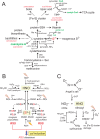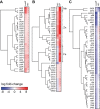Sulfide Homeostasis and Nitroxyl Intersect via Formation of Reactive Sulfur Species in Staphylococcus aureus
- PMID: 28656172
- PMCID: PMC5480029
- DOI: 10.1128/mSphere.00082-17
Sulfide Homeostasis and Nitroxyl Intersect via Formation of Reactive Sulfur Species in Staphylococcus aureus
Abstract
Staphylococcus aureus is a commensal human pathogen and a major cause of nosocomial infections. As gaseous signaling molecules, endogenous hydrogen sulfide (H2S) and nitric oxide (NO·) protect S. aureus from antibiotic stress synergistically, which we propose involves the intermediacy of nitroxyl (HNO). Here, we examine the effect of exogenous sulfide and HNO on the transcriptome and the formation of low-molecular-weight (LMW) thiol persulfides of bacillithiol, cysteine, and coenzyme A as representative of reactive sulfur species (RSS) in wild-type and ΔcstR strains of S. aureus. CstR is a per- and polysulfide sensor that controls the expression of a sulfide oxidation and detoxification system. As anticipated, exogenous sulfide induces the cst operon but also indirectly represses much of the CymR regulon which controls cysteine metabolism. A zinc limitation response is also observed, linking sulfide homeostasis to zinc bioavailability. Cellular RSS levels impact the expression of a number of virulence factors, including the exotoxins, particularly apparent in the ΔcstR strain. HNO, like sulfide, induces the cst operon as well as other genes regulated by exogenous sulfide, a finding that is traced to a direct reaction of CstR with HNO and to an endogenous perturbation in cellular RSS, possibly originating from disassembly of Fe-S clusters. More broadly, HNO induces a transcriptomic response to Fe overload, Cu toxicity, and reactive oxygen species and reactive nitrogen species and shares similarity with the sigB regulon. This work reveals an H2S/NO· interplay in S. aureus that impacts transition metal homeostasis and virulence gene expression. IMPORTANCE Hydrogen sulfide (H2S) is a toxic molecule and a recently described gasotransmitter in vertebrates whose function in bacteria is not well understood. In this work, we describe the transcriptomic response of the major human pathogen Staphylococcus aureus to quantified changes in levels of cellular organic reactive sulfur species, which are effector molecules involved in H2S signaling. We show that nitroxyl (HNO), a recently described signaling intermediate proposed to originate from the interplay of H2S and nitric oxide, also induces changes in cellular sulfur speciation and transition metal homeostasis, thus linking sulfide homeostasis to an adaptive response to antimicrobial reactive nitrogen species.
Keywords: hydrogen sulfide; nitric oxide; nitroxyl; persulfide; reactive nitrogen species; reactive sulfur species; transcriptomics.
Figures







Similar articles
-
H2S and reactive sulfur signaling at the host-bacterial pathogen interface.J Biol Chem. 2020 Sep 18;295(38):13150-13168. doi: 10.1074/jbc.REV120.011304. Epub 2020 Jul 22. J Biol Chem. 2020. PMID: 32699012 Free PMC article. Review.
-
Hydrogen Sulfide Sensing through Reactive Sulfur Species (RSS) and Nitroxyl (HNO) in Enterococcus faecalis.ACS Chem Biol. 2018 Jun 15;13(6):1610-1620. doi: 10.1021/acschembio.8b00230. Epub 2018 May 17. ACS Chem Biol. 2018. PMID: 29712426 Free PMC article.
-
Staphylococcus aureus sqr Encodes a Type II Sulfide:Quinone Oxidoreductase and Impacts Reactive Sulfur Speciation in Cells.Biochemistry. 2016 Nov 29;55(47):6524-6534. doi: 10.1021/acs.biochem.6b00714. Epub 2016 Nov 16. Biochemistry. 2016. PMID: 27806570 Free PMC article.
-
Hydrogen Sulfide and Reactive Sulfur Species Impact Proteome S-Sulfhydration and Global Virulence Regulation in Staphylococcus aureus.ACS Infect Dis. 2017 Oct 13;3(10):744-755. doi: 10.1021/acsinfecdis.7b00090. Epub 2017 Sep 6. ACS Infect Dis. 2017. PMID: 28850209 Free PMC article.
-
Sensing and regulation of reactive sulfur species (RSS) in bacteria.Curr Opin Chem Biol. 2023 Oct;76:102358. doi: 10.1016/j.cbpa.2023.102358. Epub 2023 Jul 1. Curr Opin Chem Biol. 2023. PMID: 37399745 Free PMC article. Review.
Cited by
-
Generation and Physiology of Hydrogen Sulfide and Reactive Sulfur Species in Bacteria.Antioxidants (Basel). 2022 Dec 17;11(12):2487. doi: 10.3390/antiox11122487. Antioxidants (Basel). 2022. PMID: 36552695 Free PMC article. Review.
-
The Old Yellow Enzyme OfrA Fosters Staphylococcus aureus Survival via Affecting Thiol-Dependent Redox Homeostasis.Front Microbiol. 2022 May 17;13:888140. doi: 10.3389/fmicb.2022.888140. eCollection 2022. Front Microbiol. 2022. PMID: 35656003 Free PMC article.
-
Cyanide Insensitive Oxidase Confers Hydrogen Sulfide and Nitric Oxide Tolerance to Pseudomonas aeruginosa Aerobic Respiration.Antioxidants (Basel). 2024 Mar 21;13(3):383. doi: 10.3390/antiox13030383. Antioxidants (Basel). 2024. PMID: 38539916 Free PMC article.
-
Staphylococcus aureus Glucose-Induced Biofilm Accessory Protein A (GbaA) Is a Monothiol-Dependent Electrophile Sensor.Biochemistry. 2020 Aug 11;59(31):2882-2895. doi: 10.1021/acs.biochem.0c00347. Epub 2020 Jul 29. Biochemistry. 2020. PMID: 32697076 Free PMC article.
-
H2S and reactive sulfur signaling at the host-bacterial pathogen interface.J Biol Chem. 2020 Sep 18;295(38):13150-13168. doi: 10.1074/jbc.REV120.011304. Epub 2020 Jul 22. J Biol Chem. 2020. PMID: 32699012 Free PMC article. Review.
References
-
- Soutourina O, Poupel O, Coppée JY, Danchin A, Msadek T, Martin-Verstraete I. 2009. CymR, the master regulator of cysteine metabolism in Staphylococcus aureus, controls host sulphur source utilization and plays a role in biofilm formation. Mol Microbiol 73:194–211. doi:10.1111/j.1365-2958.2009.06760.x. - DOI - PubMed
Grants and funding
LinkOut - more resources
Full Text Sources
Other Literature Sources
Molecular Biology Databases
Research Materials
Miscellaneous

